Issue #6
Mar 14, 2018
Michael Adkins
In the last issue of the DCStamps Investigator, we discussed overprints using initials. In this edition, we continue our exploration by looking at emblems and symbols.
Symbols Overprinted on Dead Country Stamps
National symbols and emblems are important for building or emphasizing a common identity. Therefore, it is no surprise that nations trying to change (or even create) its identity often used an image, rather than a name. In this edition, we will explore six “countries” which used emblems on their overprints for its postage stamps. For those of us who collect stamps, banknotes or even coins, learning these and other such symbols can make county identification far easier. Plus, we might learn a little more about the country along the way.
Ukrainian National Republic (pre-USSR)
 Soon after the Russian Revolution, Ukraine declared independence on Jan 25, 1918. The Ukrainian Peoples Republic adopted the tryzub, a unique form of a trident for as its national symbol. The tryzub played an important part in Ukraianan history, including being on the coat of arms of Volodymyr the Great, the Grand Prince of Kiev in the 10th century.
Soon after the Russian Revolution, Ukraine declared independence on Jan 25, 1918. The Ukrainian Peoples Republic adopted the tryzub, a unique form of a trident for as its national symbol. The tryzub played an important part in Ukraianan history, including being on the coat of arms of Volodymyr the Great, the Grand Prince of Kiev in the 10th century.
While Ukraine did initially issue a set of 5 stamps (called the Shagiv issues), in August, 1918, Ukrainian authorities ordered that all available stocks of Imperial Russian stamps be overprinted with the tryzub for use in Ukraine. This was done primarily make higher denominations, reduce Russian influence as well as save money by using their inventory of Imperial stamps. Six different city post offices overprinted the stamps, each with their own versions of the tryzub. A host of different designs and variations were issued. The Ukrainian Philatelic and Numismatic Society has put together a nice summary of the various versions of the trident, which I have included in my Ukraine Stamp Album.
Republic of Armenia (pre-USSR)
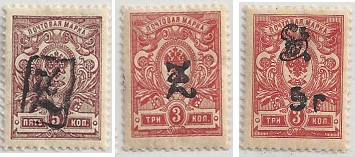 Armenia is another ethnic region of the Russian Empire which declared its independence after the revolution. As did Ukraine, Armenia took their ample supply of Russian Imperial stamps, and hand-stamped them at local post offices for use in the new republic.
Armenia is another ethnic region of the Russian Empire which declared its independence after the revolution. As did Ukraine, Armenia took their ample supply of Russian Imperial stamps, and hand-stamped them at local post offices for use in the new republic.
While technically not a symbol, the first two overprints, which resemble the letter “Z”, were formed by the combination the Armenian letters for H and P. Referring to Haykakan Post (Armenian Post), the “Z” symbol is often referred to as the “HP” monogram. The third overprint was used on surcharges of new values. Some say it is a stylized “HH” in the Armenian Alphabet which stand for Hayastanee Hanrapetutiun. Recently others have advocated that it is a combination of the Armeanian letters “DH”, which stand for Derutune Hayastanee, meaning State of Armenia. There is a large variety of these overprints available, and common for these types of issues, many are counterfeits.
Chilean Occupation of Peru
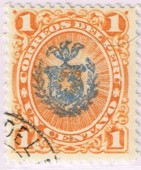 In 1879, Chile went to war against Peru and Bolivia, fighting over a Bolivian region of the Atacama Desert rich in nitrates. Nitrates are a basic ingredient of saltpeter, which is required to make gunpowder. Often called the War of the Pacific, the superior Chilean military decimated the poorly prepared Bolivian army after the first battle. However, the war continued with Peru, who was supported by the Americans. With a superior navy, Chilean forces were able to drive back the Peruvian military, ultimately capturing Lima in Jan 1881, as well as other key cities in Peru.
In 1879, Chile went to war against Peru and Bolivia, fighting over a Bolivian region of the Atacama Desert rich in nitrates. Nitrates are a basic ingredient of saltpeter, which is required to make gunpowder. Often called the War of the Pacific, the superior Chilean military decimated the poorly prepared Bolivian army after the first battle. However, the war continued with Peru, who was supported by the Americans. With a superior navy, Chilean forces were able to drive back the Peruvian military, ultimately capturing Lima in Jan 1881, as well as other key cities in Peru.
What followed was a three and a half year occupation. For postage, Chilean authorities overprinted Peruvian stamps with the Coat of Arms of Chile for use within occupied areas. Many outlying areas of the country, which supported the resistance, applied their own local overprints or even created their own crude stamps. The occupation ended in Aug 1884, when Chilean troops left the country. The disputed territory was annexed by and remains part of Chile today.
Italian Social Republic
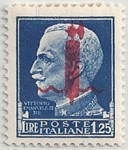 In the last issue, we covered a little bit of the history of the Italian Social Republic when we discussed GNR overprints. As the Italian Social Republic established its postal system, Italian stamps were overprinted with the fasces, the emblem of fascism. The fasces was an ancient Roman symbol of power carried by officials who were responsible for executing judgment. The fasces was an axe, with a bundle of sticks surrounding the handle. It was carried by the Roman official, indicating their power over life and death. This symbol is often used today to indicate justice, and is part of the seal of the Administrative Office of the United States Courts.
In the last issue, we covered a little bit of the history of the Italian Social Republic when we discussed GNR overprints. As the Italian Social Republic established its postal system, Italian stamps were overprinted with the fasces, the emblem of fascism. The fasces was an ancient Roman symbol of power carried by officials who were responsible for executing judgment. The fasces was an axe, with a bundle of sticks surrounding the handle. It was carried by the Roman official, indicating their power over life and death. This symbol is often used today to indicate justice, and is part of the seal of the Administrative Office of the United States Courts.
Japanese Occupation of Burma
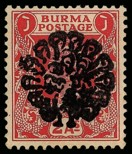 During World War 2, the Japanese occupied much of southeast Asia, including British Burma. Early in the occupation, post offices in the delta region requested the ability to use existing inventory of British Burma stamps. The Japanese agreed, provided that the head of the king be covered with a Burmese emblem. The peacock was chosen, and local post offices created their own designs for overprinting. The overprints were applied by hand at the post office for use in May 1942. Different colors of ink were used making for different varieties. Many counterfeits are available, as genuine stamps can be quite valuable.
During World War 2, the Japanese occupied much of southeast Asia, including British Burma. Early in the occupation, post offices in the delta region requested the ability to use existing inventory of British Burma stamps. The Japanese agreed, provided that the head of the king be covered with a Burmese emblem. The peacock was chosen, and local post offices created their own designs for overprinting. The overprints were applied by hand at the post office for use in May 1942. Different colors of ink were used making for different varieties. Many counterfeits are available, as genuine stamps can be quite valuable.
Japanese Occupation of the Dutch East Indies
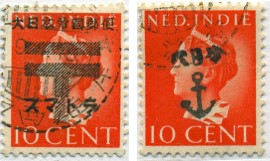 While these stamps are easy to identify, as they have Japanese writing on a Netherlands Indies stamps, I included them because Japanese occupation stamps of the former Dutch islands can be quite complicated. Neither of these two examples are included in the Scott Catalogue (at the least the editions I have). The first uses the Japanese yūbin kigō, or postal symbol, and was issued in the occupation of the island of Sumatra.
While these stamps are easy to identify, as they have Japanese writing on a Netherlands Indies stamps, I included them because Japanese occupation stamps of the former Dutch islands can be quite complicated. Neither of these two examples are included in the Scott Catalogue (at the least the editions I have). The first uses the Japanese yūbin kigō, or postal symbol, and was issued in the occupation of the island of Sumatra.
The second emblem shown is an anchor. It was often used by areas occupied by the Japanese Navy, primarily Borneo and many of the outer islands such as Bali and Ambon. The picture shown was issued in North Celebes (today Sulawesi). While this is of course not a national symbol, it does represent Japanese navy control.
Technically, I would consider these as separate “countries”, as Japan divided the Dutch East Indies into three separated occupational administrations. Java and Sumatra had separate “governments”, and Borneo and the Great East was administered by the navy.
Collecting Dead Countries
While most of the overprints I have been featuring in this blog usually designate sovereignty or control, not all overprints are used for such purposes. I am currently working through my Ottoman Empire stamps, and they use overprints for a wide variety of purposes. Ottoman stamps have overprints to indicate a newspaper stamp, overprints to indicate that buyers get a discount, and overprints to celebrate a sultans visit to a city. In fact, where other countries print and issue commemorative stamps, the Ottoman Empire uses overprints. Being that almost everything is in Turkish, trying to sort through all of them truly lives up to the title of the series “Overprint Madness.”
In the next edition of the DCStamps Investigator, I will begin winding up the series by covering some of the very confusing, and more maddening overprinted issues. I will include overprints on overprints and even some issues which are very misleading.
I would love to hear from you by leaving a comment below.






Michael,
Nice post. Turkey/Ottoman Empire is one country I collect. As I’m sure you are finding out, their use of overprints is quite extensive. There is an ongoing Turkey thread on SCF with several real experts if you get stuck.
Good luck with the blog in 2018!
-Chris
Hi Chris
Nice to hear from you, and welcome to DCStamps. Actually, I am following that thread fairly closely as I am in process of slowly organizing my measly Ottoman stamps. I have actually posted a couple of times asking questions, and haven taken advantage (as one person stated it), of “Nigelpedia”. I have also been following and posting on a Turkey/Ottoman Thread on Stamp Bears as well.
Stay in touch
Michael